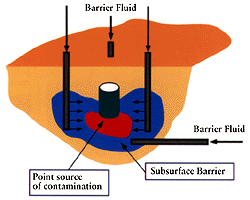

Heart Disease Risk: One Diet Does Not Fit All
Vigorous Exercise for Women May Lead to Greater Health Benefits
Human Genome Lab Groundbreaking
New Device Cleans Water with Light
Research Reveals Growth Factor's Role in Cancer Treatment
New Device Lowers Radiation Exposure During Dental X-Rays
Gas Emissions Provide Clue to Volcanic Activity
New Technique Stops Spread of Hazardous Waste
Virtual Laboratories Debuting on the Internet


New Technique Stops Spread of Hazardous Waste
A new technique developed by Berkeley Lab researchers could make it possible to
contain and prevent the spread of underground hazardous waste.
Collaborating with the Bechtel Corp., Berkeley Lab demonstrated the feasibility
of the concept in January 1995 at a site with complex subsurface conditions similar to those at Hanford, Washington. If the development effort continues to be
successful, the technique could substantially reduce both the financial and
environmental costs associated with the country's thousands of hazardous waste
sites.
To immobilize waste, the Berkeley Lab team drills a string of wells around and
beneath the perimeter of the area that is to be contained. Then, they inject a
fluid into the wells which is able to permeate the ground before later gelling
and forming an impermeable, solid barrier that surrounds the contaminated site.
Earth scientists Karsten Pruess and George Moridis liken their technique to the
creation of an underground isolation chamber.
"Up until now," says Moridis, "the country has been fighting a losing battle.
Huge areas can be contaminated by just a few gallons of hazardous fluids, and
once they get into the ground, contaminants are very difficult to strip from the
soil. Unfortunately, the state of the art of cleaning up these sites is the same
as it was 30 years ago-we dig the soil out and truck it to a hazardous waste
site."
As they moved their technique from the lab to the field, Berkeley Lab project
chemists John Apps and Peter Persoff worked with chemical companies including Dow
Corning, DuPont, and Philadelphia Quartz Corp. to refine the performance of the
gel barrier fluids. Fluids chosen for testing are environmentally benign, so much
so that they have been given a categorical exclusion from EPA and NEPA
regulations.
For the recent field test, LBL injected two fluids, a colloidal silica and a
polysiloxane fluid into the unsaturated soil zone above the water table. Several days later researchers excavated the grout plumes,
slicing the earth away to reveal how well they had managed to penetrate and
saturate the uneven ground.
The colloidal silica performed satisfactorily but the polysiloxane exceeded
expectations. Bechtel specialists who have been injecting materials into the
ground for two decades say the material did something they had never seen before.
"Not only did we see a uniform, almost symmetrical plume," reports Moridis,"but the polysiloxane displayed a remarkable ability to penetrate small and large
pores in the relatively clay soil matrix."
When injected into the earth, polysiloxane has a viscosity similar to water. A
catalyst causes it to turn into a strong, rubber-like polymer, and controls how
quickly this occurs. Soil chemistry, which can cause a compound to solidify
prematurely, does not significantly affect polysiloxane. The product, a silicon-chain
polymer, was developed by Dow Corning for Berkeley Lab.
Precisely how long such barriers would last in the earth -- a relatively short
time or a millennium -- must still be determined, although the life expectancy of
similar products is 30 to 50 years. During remediation, even a barrier with a
lifetime of months can be useful, helping to contain or redirect groundwater
flows.
Besides their use at hazardous waste sites,such barriers have other potential
applications. These include the lining and capping of landfills, the
stabilization of slide-prone slopes, and the prevention of soil liquefaction in
earthquake-prone areas.
 The costs and limitations of this approach have severely handicapped the nation's
cleanup efforts. Thousands of contaminated sites have been identified but few
have been cleaned up. Typically, years elapse before cleanup begins at a site.
The costs and limitations of this approach have severely handicapped the nation's
cleanup efforts. Thousands of contaminated sites have been identified but few
have been cleaned up. Typically, years elapse before cleanup begins at a site.


